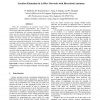9 search results - page 1 / 2 » Directional Versus Omnidirectional Antennas for Energy Consu... |
OPODIS
2004
13 years 6 months ago
2004
A network is k-connected if it remains connected after the removal of any k - 1 of its nodes. Assume that n sensors, modeled here as (omni)directional antennas, are dropped random...
ICDCS
2005
IEEE
13 years 10 months ago
2005
IEEE
With the development of location aware sensor applications, location determination has become an increasingly important middleware technology. Numerous current technologies for lo...
INFOCOM
2006
IEEE
13 years 11 months ago
2006
IEEE
— Directional antennas are a promising option for use in ad-hoc networks for a variety of reasons, such as increased spatial reuse, reduced interference and enabling more effici...
VTC
2007
IEEE
13 years 11 months ago
2007
IEEE
– Integration of beamforming to sensors is very beneficial for a reduction of transmission power consumption and for improvement of the overall system performance. Unfortunately,...
TPDS
2010
13 years 3 months ago
2010
—In this paper, we consider the issue of efficient broadcasting in mobile ad hoc networks (MANETs) using network coding and directional antennas. Network coding-based broadcastin...

